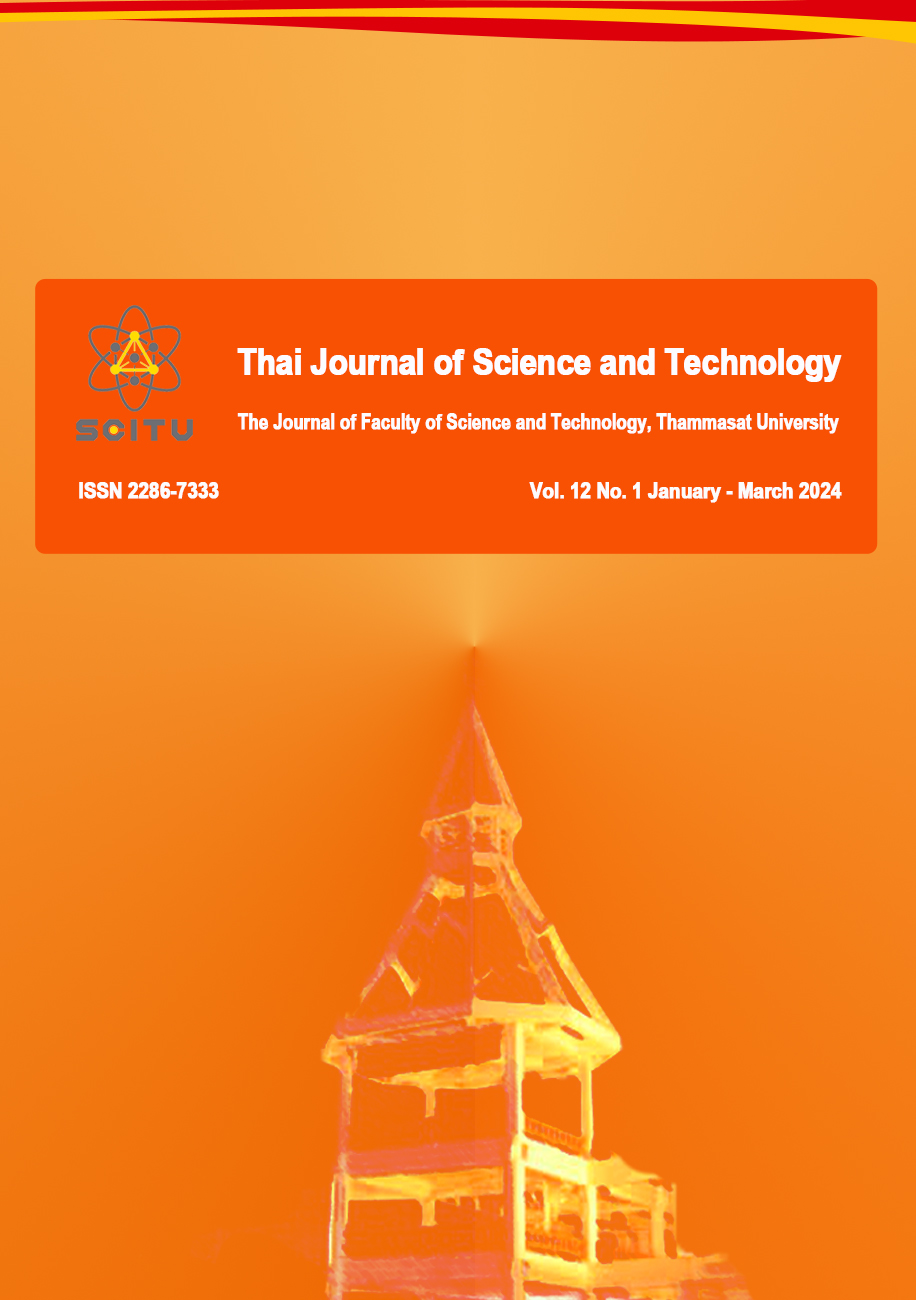เปรียบเทียบลักษณะทางสัณฐานวิทยาและกายวิภาคศาสตร์ของ ผักแขยง (Limnophila aromatica Merr) พรมมิ (Bacopa monnieri (L.) Wettst) ลานไพลิน (Bacopa caroliniana (Walt) Robins)
Main Article Content
บทคัดย่อ
การระบุชนิดพืชผักและสมุนไพรพื้นบ้านโดยใช้ลักษณะทางสัณฐานวิทยาเพียงอย่างเดียวอาจไม่เพียงพอ จึงต้องอาศัยการศึกษาด้านอื่น ๆ ประกอบด้วย โดยกายวิภาคศาสตร์ของพืชเป็นอีกหนึ่งเครื่องมือที่ช่วยจัดจำแนกพืช ผักแขยง พรมมิ และลานไพลิน เป็นพืชในวงศ์เดียวกันและมีถิ่นอาศัยใกล้เคียงกัน อาจสร้างความสับสนให้แก่ผู้บริโภค จึงนำผักแขยง พรมมิ และลานไพลินมาศึกษาลักษณะสัณฐานวิทยาของลำต้น ใบ และดอกด้วยกล้องจุลทรรศน์แบบสเตอริโอ และศึกษาลักษณะกายวิภาคศาสตร์ของเนื้อเยื่อผิวใบและลำต้นด้วยกล้องจุลทรรศน์แบบใช้แสงเพื่อเปรียบเทียบและจำแนกชนิดพืช เมื่อพิจารณาจากลำต้นและใบสามารถใช้ขนที่ปกคลุมจำแนกได้ โดยลำต้นของพรมมิไม่มีขน จากนั้นจำแนกผักแขยงและลานไพลินด้วยลักษณะรูปร่างใบ เมื่อพิจารณาจากดอกสามารถใช้กลีบเลี้ยงจำแนกผักแขยงออกจากพืชอีก 2 ชนิดได้ จากนั้นจำแนกพรมมิและลานไพลินได้ด้วยสีบริเวณโคนกลีบดอก หากใช้ลักษณะทางกายวิภาคศาสตร์สามารถใช้จำนวนชั้นช่องอากาศจำแนกลานไพลินออกจากผักแขยงและพรมมิ จากนั้นใช้เนื้อเยื่อคอลเลงคิมาของลำต้นจำแนกผักแขยงออกจากพรมมิ โดยผักแขยงมีเนื้อเยื่อคอลเลงคิมาอย่างชัดเจน จากลักษณะทางสัณฐานวิทยาและ/หรือกายวิภาคศาสตร์สามารถใช้จำแนกผักแขยง พรมมิ และลานไพลินออกจากกันได้ และเป็นการเพิ่มพูนข้อมูลทางกายวิภาคที่ยังมีจำกัดในพืชกลุ่มนี้ นอกจากนั้นยังสามารถประยุกต์ใช้ในการศึกษาด้านอื่น ๆ ที่เกี่ยวข้อง ตลอดจนนำไปสู่การพัฒนาและอนุรักษ์ทรัพยากรพันธุกรรมพืชให้เกิดประสิทธิภาพต่อไป
Article Details

อนุญาตภายใต้เงื่อนไข Creative Commons Attribution-NonCommercial-NoDerivatives 4.0 International License.
บทความที่ได้รับการตีพิมพ์เป็นลิขสิทธิ์ของคณะวิทยาศาสตร์และเทคโนโลยี มหาวิทยาลัยธรรมศาสตร์ ข้อความที่ปรากฏในแต่ละเรื่องของวารสารเล่มนี้เป็นเพียงความเห็นส่วนตัวของผู้เขียน ไม่มีความเกี่ยวข้องกับคณะวิทยาศาสตร์และเทคโนโลยี หรือคณาจารย์ท่านอื่นในมหาวิทยาลัยธรรมศาสตร์ ผู้เขียนต้องยืนยันว่าความรับผิดชอบต่อทุกข้อความที่นำเสนอไว้ในบทความของตน หากมีข้อผิดพลาดหรือความไม่ถูกต้องใด ๆ
เอกสารอ้างอิง
Brugger, N. (2021). Plant-part anatomy related composition of the volatile oils in Limnophila aromatica (Lam.) Merr. (Plantaginaceae): An important herb used for anti-flatulence. Department of Pharmacognosy Faculty of Pharmaceutical Sciences, University of Graz, Austria.
Chiwapreecha, B., Tangtreamjitmun, N., & Janprasert, K. (2018). A Comparison of Some Rice Properties from Organic and Conventional Rice Paddy Fields. Science Faculty, Burapha University.
Chiwapreecha, B., & Thaima, S. (2019). Comparative anatomy and pollen morphology of pondweed (Monochoria hastate (L.) Solms var. hastata) and water hyacinth (Eichhornia crassipes (Mart.) Solms). Journal of Research Unit on Science, Technology and Environment for Learning, 10(2), 151-165. (in Thai)
Dethvongsa, S. (2015). Effects of Plant Growth Regulators on Shoot and Root Induction from Different Explants of Bacopa caroliniana (walt) Robins. In Vitro. (Master’s degree) Biology education, Burapha University.
Deyuan, H., Hanbi, Y., Cunli, J., & Holgren, N.H. (1998). Scrophulariaceae. In W. Zhengyi and P. H. Raven [eds.], Flora of China, vol. 18, 1–212. Missouri Botanical Garden Press, St. Louis, Missouri, USA.
Gettys, L., & III, C.J.D.T. (2018). Lemon bacopa: Bacopa caroliniana. , UF/IFAS Extension Service, University of Florida.
Kaveeta, L. (2016). Plant Structure. Department of Botany, Faculty of Science, Kasetsart University.
Khonkayan, S., Jonsonchai, S., & Namang, S. (2019). Comparative leaf epidermal anatomy of tribe Ruellieae (Acanthaceae) in Northeastern Thailand. Srinakharinwirot Science Journal, 35(2), 61-76. (in Thai)
Maikami, M., Kanto, U., Sonjaroon, W., & Promdang, S. (2022). Comparative effects of organic and inorganic fertilizers on growth, antioxidant activity and bacoside content in Bacopa monnieri (L.) Wettst. International Journal of Agricultural Technology, 18(4), 1683-1700.
Muadsub, T. (2008). Diversity of Vascular Plants Along Bangwan and Tamnang Streams in Kuraburi District, Phang-Nga Province. (Master’s degree) Master of Science in Botany, Prince of Songkla University. (in Thai)
Nakchat, O., Aekthong, W., & Kongluk, O. (2014). Phenolic contents and antioxidant activity in Limnophila aromatiaca Merr. Powder. Koch Cha Sarn Journal of Science, 36(2), 55-64. (in Thai)
Piekkoontod, T., & Sattayavibul, A. (2020). Riparian area, relationship between land utilization and environmental quality case study: Tha Chin Watershed. Journal of Multidisciplinary Academic Research and Development, 2(2), 30-44.
Pinpirom, S., Laohavisuti, N., & Ruangdej, U. (2020). Effect of Phosphorus Concentration on Growth and Antioxidant Properties in Bacopa monnieri (L.) Wettst. Growing in In Vitro Cultures. King Mongkut's Agricultural Journal, 38(4), 449-458. (in Thai)
Promsing, J., Srinua, A., & Kesonbua, W. (2016). Leaf epidermal anatomy of some species of the family Phyllanthaceae in Thailand.
Journal of Science and Technology, Ubon Ratchathani University, 18(3), 87-99. (in Thai)
Savvides, A., Fanourakis, D., & Van Ieperen, W. (2012). Co-ordination of hydraulic and stomatal conductances across light qualities in cucumber leaves. Journal of Experimental Botany, 63(3), 1135-1143.
Sudhakaran, M. V. (2020). Botanical pharmacognosy of Bacopa monnieri (Linn.) Pennell. Pharmacognosy Journal, 12(6), 1559-1572.
Tanee, W. Saensouk, P., & Saensouk, S. (2014). Leaf surface morphology and anatomy of some species of Leeaceae in Thailand. Khon Kaen University Journal, 19(2), 245-260. (in Thai)
Wongkaew, W. (1992). Principal Plant Physiology. Bangkok. Funny Publishing. (in Thai)
Yeung, C. E. (1998). A beginner's guide to the study of plant structure. Tested Studies for Laboratory Teaching, 19, 125-141.


